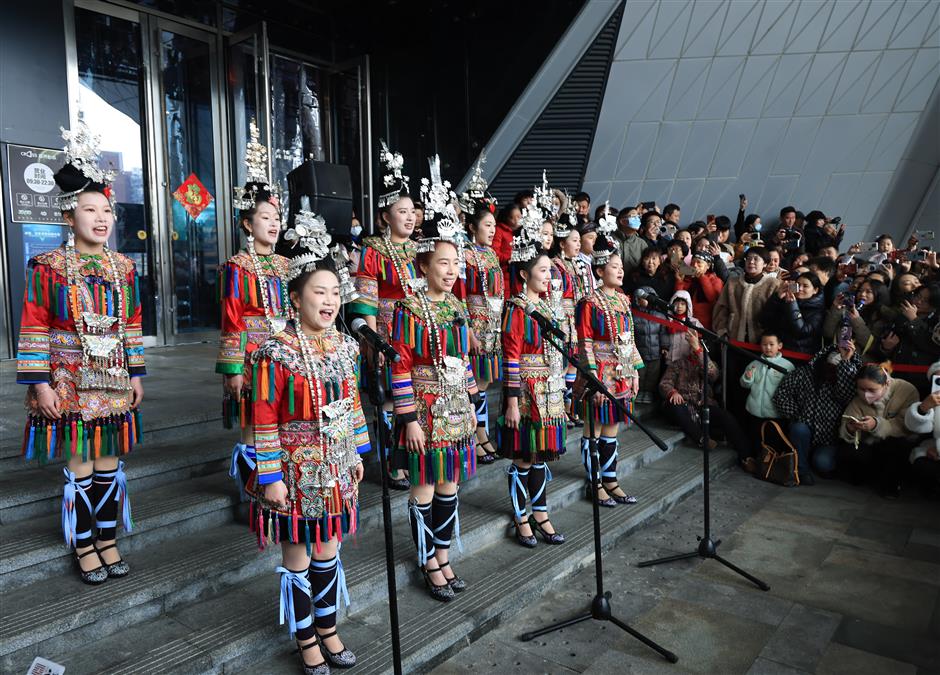Singing as a way of life! Blending tradition and innovation to revive Dong Grand Song
Editor's note:
The United Nations has officially designated 44 Chinese traditions as world cultural heritage. This series examines how each of them defines what it means to be Chinese.

The Dancing Cicadas Ensemble, a Guizhou-based soundtrack team for "Ne Zha 2," performs the Grand Song of the Dong ethnic group at Yuejie Cinema in Guiyang, Guizhou Province, on February 25.
Chinese animation blockbuster "Ne Zha 2" opens with a haunting polyphonic chant, which has impressed many viewers. The ancient sound of the Grand Song of the Dong ethnic group has sparked nationwide interest as the film shattered numerous box-office records inside and outside China.
In the remote villages of Guizhou Province and the Guangxi Zhuang Autonomous Region in south China, the Grand Songs have echoed through bamboo forests and wooden drum towers for more than 2,500 years.
Recognized by the United Nations Educational, Scientific and Cultural Organization (UNESCO) in 2009 as a Masterpiece of the Intangible Cultural Heritage of Humanity, the folk tradition defies modern musical conventions: no instruments, no conductor, just voices weaving nature's symphony into human harmony.
The choirs mimic the sounds of cicadas, flowing rivers and mountain winds, a practice born from the Dong people's deep connection to their environment. Lyrics encode local history, folk medicine, romantic tales and moral values, making the tradition a Dong encyclopedia.
The choirs, performed during festivals or communal gatherings in drum towers, blend high-pitched solos with resonant low harmonies, a structure UNESCO describes as "a model of cultural diversity and human creativity."

Dong women sing the Grand Song in Guizhou's Longli Ancient Town on February 11.
The tradition remained hidden until 1953, when Dong singers from Guizhou's Liping County stunned scholars at China's first national folk music festival.
Decades later, in 1986, a performance at Paris' Autumn Arts Festival drew global acclaim, silencing the myth that China lacked polyphonic music. Some foreign audiences called it "music from another planet."
Wu Pinxian, 80, is a nationally recognized inheritor of the choirs. Born in Liping's Sanlong Village, she began learning Dong songs at age 4 from her grandmother and parents.
In 1958, she joined a local folk choir and was later invited to perform with the China National Song and Dance Ensemble in Beijing.
But homesickness took her back to the mountains, where she spent decades teaching songs in schools, drum towers and rice fields — often unpaid.
Over the past 40 years, she has taught more than 2,000 students, including foreigners. Today, her village hosts nine choirs across age groups.
"This is our family treasure," she told Guizhou TV Station. "My greatest joy is seeing my students pass these songs to the next generation."

A children's choir performs at a Dong Grand Song competition in Congjiang County, Guizhou Province, on December 21.
For centuries, Dong children joined village song teams by age 6, learning from master singers through oral traditions, but urbanization and migration threaten this ecosystem.
A recent World Bank report found that while older villagers know how to sing Dong songs, people aged 18 to 30 "know very little about Dong songs," citing migration and changing livelihoods as chief causes.
In Liping County, known as the hometown of the Dong Grand Song, rural tourism events still draw thousands of visitors for nightly performances, but few local youths join the choirs.
Efforts to revive the Grand Song blend tradition and innovation.
Wu Chunyue, a folk singer from Guangxi's Sanjiang Dong Autonomous County, has devoted herself to teaching and preserving the tradition. She now trains students at local schools and has formed a new singing group to ensure the songs are passed on.
"No matter how hard it is, I must keep singing and teaching," Wu told Linxia Integrated Media Center.
The 39-year-old has trained more than 1,200 students since 2015.
Wu learned the songs from her parents and neighbors during village gatherings. At 15, she began training under her aunt, a local master singer. She dropped out of school due to poverty but memorized more than 50 songs through oral tradition.

Performers from Sanjiang Dong Autonomous County, south China's Guangxi Zhuang Autonomous Region, sing the Dong Grand Song in Nanning, the regional capital, on April 1.
Wu rose to national fame in 2008 when her group reached the top 20 in the China Central Television Youth Singer Competition. Since then, she has performed across China and uses every opportunity to promote Dong culture.
In Rongjiang County of Guizhou, chorus founder Yang Xiangni returned after graduating from Guizhou University's music academy.
Since 2023, her troupe has performed at rural festivals and toured nationally. Her chorus featured in "Ne Zha 2" and brought the ancient heritage of the Grand Song to the smash hit film. Director Yang Yu said: "This is the Chinese sound I was looking for."
UNESCO's designation also boosted tourism, with cultural festivals in Liping and Congjiang counties attracting tens of thousands of visitors annually.
During the Spring Festival, villages compete in marathon singing duels, where matches often spark romances.
For the Dong people, singing is more than art but daily life.
"Rice feeds the body, and songs feed the soul," goes a local proverb.
Digital archives now store thousands of song variants. Virtual-reality tours of drum towers let distant audiences explore village architecture while listening to authentic performances.
"Our songs survived wars and storms. With the world's help, they'll outlive us all," said Wu Chunyue.











